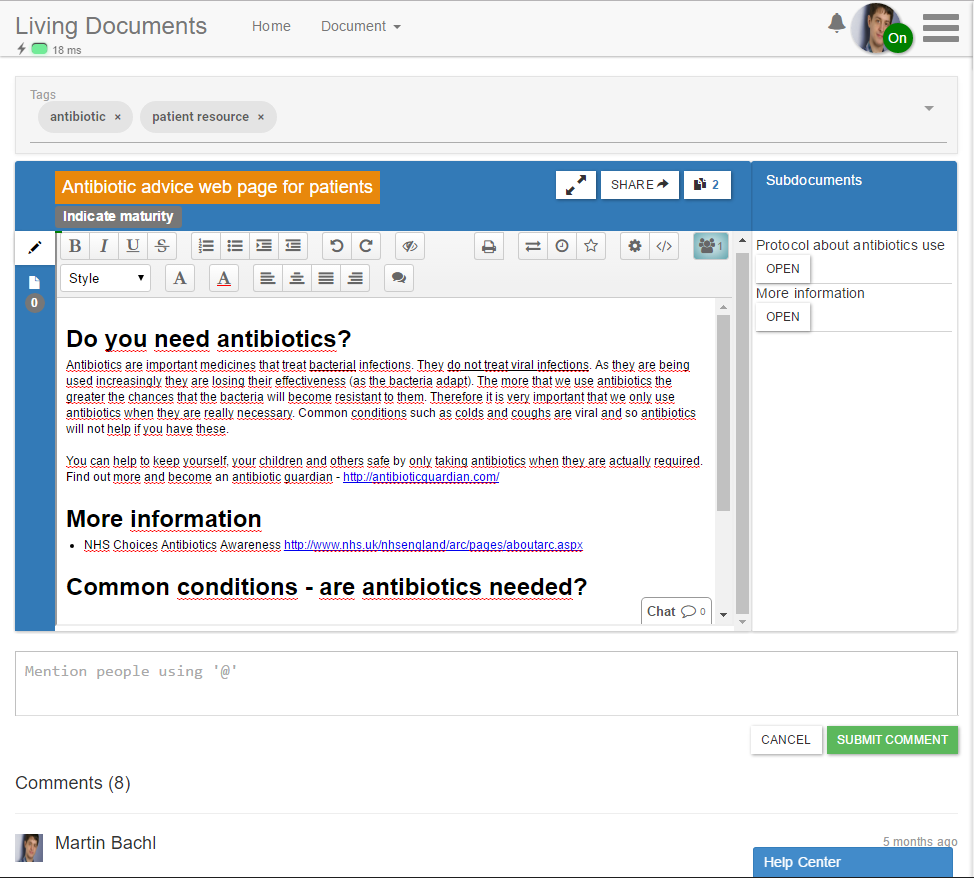Authors: Martin Bachl, Zahra Grosser, Christine Kunzmann, Andreas Schmidt, David Zaki
LivingDocuments is an application that allows to create, edit and discuss documents collaboratively. Based on the metaphor of a living document LivingDocuments enables users to have agreed, stable document parts, and the possibility to attach less mature pieces to those parts. Document sharing in LivingDocuments shows changes in real-time and thus offers others the chance to immediately take part in the social process of content creation and/or content enhancement for already existing documents.
supported by a near real-time collaborative document environment
the content with others directly inside the document using comments or commented paragraphs as well as contextualized subdocuments to discuss paragraphs of the main document in a smaller group or just separately to avoid long and complex interactions in the main document that would otherwise be too distracting.
of content changes and activity of other users by supporting track changes to a document over time (time-based versioning) inside the tool and email or in-app notifications about document change events on content, comments or discussions.
and related maturity aspects to enhance judging the reliability for a specific purpose for users of the document which are not involved in the process.
Uses
Following knowledge maturing activities are supported by living documents platform:
- Explicit representations of knowledge
By embedding knowledge into the context of a living document, it enables wider conversations and increasing the scope of participants in a knowledge maturing process. As a “living” document, it also removes the expectation that it is already well developed, which might not be appropriate when the underlying knowledge is still in early stages of maturity. - Refinement and further development of knowledge
A living document creates a space for conversations for further development of knowledge, which is intertwined with the amendment of document. Such development can result from the changes to the overall context (making it outdated), or the advancement along the maturing process. - Awareness of existing knowledge
Creating awareness about ongoing knowledge maturing processes is key to keeping the engine of knowledge maturing processes running. It creates the audience and ensures that participants of such a process stay active contributors. To foster this, several awareness features are provided by the LivingDocuments Platform already today and will be further enhanced in the future. This also helps for the aspect of keeping existing knowledge in the system up-to-date. - Knowledge sharing
A key enabler for the LivingDocuments Platform is it provides an excellent basis for collective knowledge development and sharing.

Tech specs
Basic information
- LivingDocuments is currently designed to be a desktop web app. Since it is a web app it also allows for reading the document content on mobile devices although editing them is not recommended on mobile devices at this stage. As an outlook LivingDocuments may be adjusted more to mobile devices in the upcoming months.
- As of now the web app requires internet connectivity and is not able to work offline.
- Module-based configurable authentication services for the web app.
Technology overview
Client-side
- React framework for building user interfaces in Javascript.
- Bootstrap 3 css and javascript support for device adjusting layouts.
- Meteor for data handling client-side and exchanging data with the server through the Distributed Data Protocol (DDP).
Server-side
- Meteor for publishing data to clients, authentication, security and more. Additionally Meteor handles the communication to the currently used MongoDB database in a unified way enabling the same queries on the client-side as on the server-side.
- Running currently on a Node.js server 4.4.7 LTS.
Deployment via Docker containers (server, database and other components).
Designed to be potentially self-hosted inside your company.
For more in-depth technology specs read more on the LivingDocuments Github Project.
The Story
The co-design process for LivingDocuments was started during Learning Layers Design Conference in March 2013 under the heading “Pandora”. Out of this Pandora co-design a tool that revolved around developing guidelines or contextualizing guidelines resulted which was named LivingDocuments. The name originated from the metaphor of a “living document” which consists of agreed, stable parts, and possibility to attach less mature pieces to those parts.
LivingDocuments was initially designed for the purpose of creating action plans derived from national guidelines for general practices or practice clusters in the healthcare sector. With the goal in mind to get a shared understanding of how to apply national guidelines in practice within a general practice or cluster/region.
The major design concepts, the main capabilities as well as the derived benefits have been presented at the I-KNOW conference in 2014, a major conference on knowledge management using an exploratory prototype. The LivingDocuments system has won the Best Demo Paper award. It was presented to more than 500 participants amongst a group of 29 demos (ILIN News - Best Demo Paper Award).
More recently the focus of the project was around rounding up the feature portfolio as well as system reliability and security in order to provide a solid base product for productive deployments.
Research
Triggered by the initial Learning Layers design conference the project started out with a co-design phase.
Throughout the co-design process the tool has been designed and developed by performing interviews, drafting user stories, organising conversational workshops as well as through feedback from demo installations and evaluation pilots.
By using a two-tier approach new design concepts and functionality could on one hand be developed and tested without any constraints in an experimental version and in parallel fine-tuned and tested to high quality standards in a stable version.
While the experimental version of LivingDocuments gave the opportunity to test out design ideas and new functionality that gave users a first impression and feel how they would benefit from the usage. As an outcome, some of the functionality has been embedded in the commercial software Intradoc247. By that the project enabled gathering feedback from end users without deploying yet a completely new software.
LivingDocuments addresses the following Design Patterns that have been identified in Y3:
- PATTERN LD1: Conversation-oriented collaborative document creation through stable and unstable collaboration artefacts
- PATTERN LD2: Conversation-oriented collaborative document creation through nested documents
- PATTERN LD3: Indicate knowledge maturity in shared document spaces
Contact
Martin Bachl, University of Applied Sciences Karlsruhe - Institute of Applied Sciences - Institute for Learning and Innovation in Networks (Email: martin.bachlhs-karlsruhe.de)
Philipp Dallmann, University of Applied Sciences Karlsruhe - Institute of Applied Sciences - Institute for Learning and Innovation in Networks (Email: philipp.dallmannhs-karlsruhe.de)
Or visit our Github Project.
Contact
Links
- Research papers: [1] [2]
- Github
- Learning scenario: Knowledge Maturing in Collaborative Spaces
- Use Cases & Impacts:
References
- M. Bachl, D. Zaki, A. Schmidt, and C. Kunzmann, “Living Documents as a Collaboration and Knowledge Maturing Platform,” in International Conference on Knowledge Management (I-KNOW 2014), 2014 [Online]. Available at: http://publications.andreas.schmidt.name/2014_IKNOW_demo_livingdocs.pdf
- T. Ley, J. Cook, S. Dennerlein, M. Kravcik, C. Kunzmann, K. Pata, J. Purma, J. Sandars, P. Santos, A. Schmidt, M. Al-Smadi, and C. Trattner, “Scaling informal learning at the workplace: A model and four designs from a large-scale design-based research effort,” British Journal of Educational Technology, vol. 45, no. 6, pp. 1036–1048, Sep. 2014. DOI: 10.1111/bjet.12197


